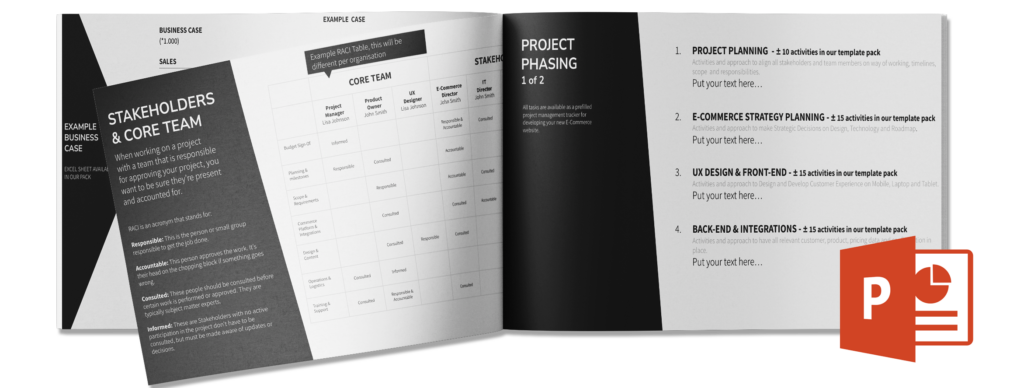Project management for B2B e-commerce requires a nuanced approach distinct from B2C e-commerce. Each phase of a project—Strategy Planning, Design, Development, and Deployment—has unique considerations that cater to the complex needs of B2B transactions. Check our free Project Management template. This detailed guide will explore these differences, providing project managers with insights to successfully navigate the B2B e-commerce landscape.

Strategy Planning for Project Managers
B2B vs. B2C
B2C E-commerce
- Consumer-Centric: Strategy focuses on attracting and retaining individual consumers.
- Short Sales Cycles: Purchases are typically impulse-driven with minimal decision-making.
- Volume and Speed: Emphasis on high transaction volumes and fast purchasing processes.
B2B E-commerce
- Relationship-Driven: Involves building and maintaining long-term relationships with business clients.
- Complex Sales Cycles: Sales cycles are longer, involving multiple stakeholders and decision-makers.
- Customization and Negotiation: Often requires tailored pricing, bulk ordering, and customized solutions.
Key Considerations for B2B Strategy Planning
- Client Relationship Management: Focus on developing strategies that nurture long-term business relationships, leveraging CRM systems to manage interactions and contracts effectively.
- Sales Funnel Management: Implement strategies to guide business clients through longer sales cycles, with touchpoints for multiple stakeholders involved in the purchasing decision.
- Market Segmentation: Identify and target specific business sectors, understanding their unique needs and creating customized value propositions.
Design and impact on Project Management for E-Commerce
B2B vs. B2C
B2C E-commerce
- User Experience: Prioritizes a smooth, engaging, and visually appealing user experience to drive quick purchases.
- Simplified Navigation: Easy-to-navigate interfaces to facilitate fast decision-making.
- Broad Appeal: Design caters to a wide audience with general user needs.
B2B E-commerce
- Functional Design: Focuses on functionality, ease of use, and efficiency for business users.
- Role-Based Access: Requires interfaces that support different user roles within an organization, such as buyers, approvers, and finance managers.
- Complex Product Information: Needs to present detailed product specifications, datasheets, and configuration options.
Key Considerations for B2B Design
- User Roles and Permissions: Design interfaces that accommodate various user roles within a business, providing appropriate access and functionality for each role.
- System Integration: Ensure seamless integration with ERP, CRM, and other business systems for real-time data exchange and process automation.
- Detailed Product Catalogs: Develop robust product information management systems to handle complex product details, technical specifications, and customizable options.
Development of Commerce platforms
B2B vs. B2C
B2C E-commerce
- Rapid Development: Emphasizes speed to market and frequent updates to keep up with consumer trends.
- Simplified Systems: Development focuses on streamlined systems to handle high volumes of simple transactions.
- User-Centric Features: Development of features aimed at enhancing the consumer shopping experience.
B2B E-commerce
- Robust and Scalable Systems: Requires development of systems capable of handling complex transactions and large data volumes.
- API and Integration Focus: Necessitates strong API capabilities for integration with various business applications and third-party services.
- Customization and Flexibility: Development must support extensive customization to meet diverse client needs and workflows.
Key Considerations for B2B Development
- Scalability and Reliability: Build platforms that can scale efficiently to handle increasing transaction volumes and complex data processing without compromising performance.
- API-Driven Architecture: Develop with an API-first approach to facilitate integration with clients’ existing systems and enable future scalability.
- Customizability: Ensure the platform is easily customizable to cater to specific client requirements, enabling quick adaptation to changing business needs.
Deployment of a B2B versus B2C Commerce Website
B2B vs. B2C
B2C E-commerce
- Speed and Efficiency: Deployment focuses on quickly launching new features and updates to meet market demands.
- Minimal Disruption: Emphasis on deploying updates with minimal impact on the user experience.
B2B E-commerce
- Thorough Testing: Requires extensive testing to ensure stability and compatibility with business workflows and integrations.
- Training and Support: Deployment involves comprehensive training for client users and ongoing support to ensure smooth adoption and operation.
- Continuous Improvement: Focus on continuous monitoring and optimization to meet evolving business requirements and maintain high performance.
Key Considerations for B2B Deployment
- Rigorous QA Processes: Implement thorough quality assurance protocols to test all aspects of the platform, ensuring it meets the specific needs of business clients.
- User Training: Provide detailed training programs and resources to help client teams understand and utilize the platform effectively.
- Ongoing Support and Optimization: Establish robust support structures to assist clients post-deployment and continuously monitor the platform for improvements and updates.
Wrap-Up: B2C versus B2B Project Management
Project management for B2B e-commerce demands a tailored approach that recognizes the distinct differences from B2C e-commerce. By focusing on relationship management, functional design, robust development, and comprehensive deployment strategies, project managers can effectively address the complexities of B2B transactions and deliver successful e-commerce solutions. Understanding and implementing these key differences will enable project managers to drive efficiency, customer satisfaction, and business growth in the B2B e-commerce space.
For more in-depth information and case studies on B2B e-commerce, refer to comprehensive guides and whitepapers specific to this domain.


